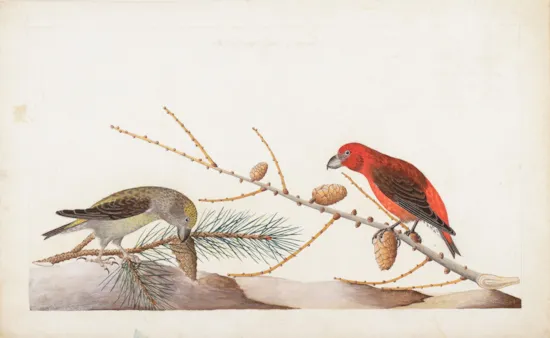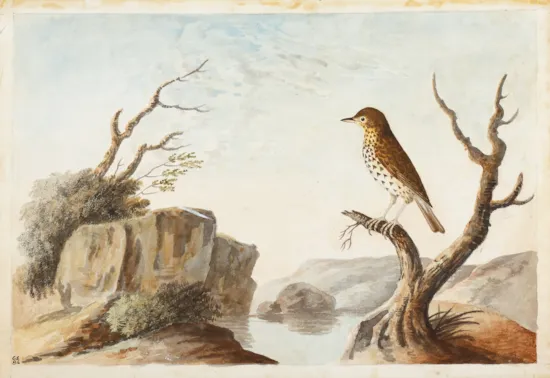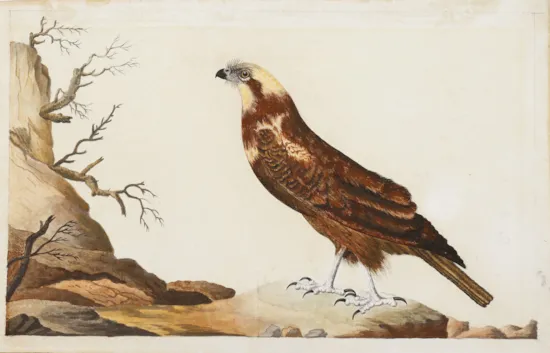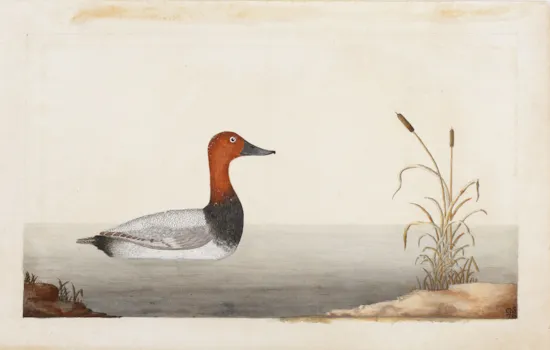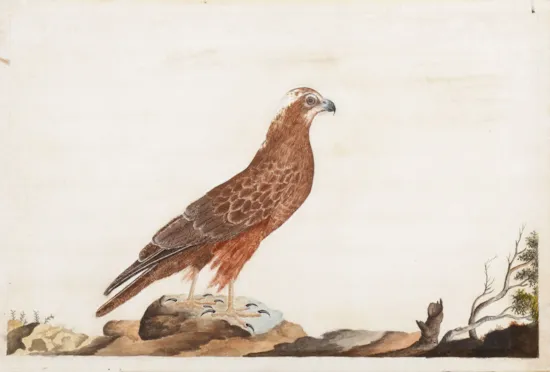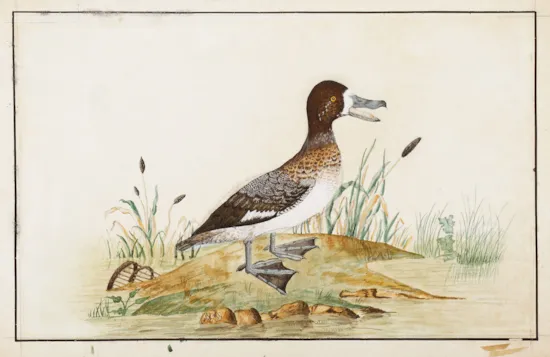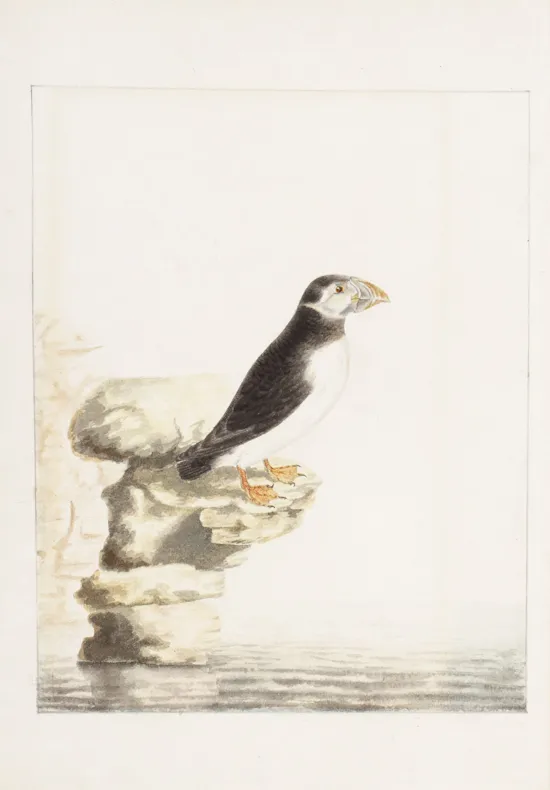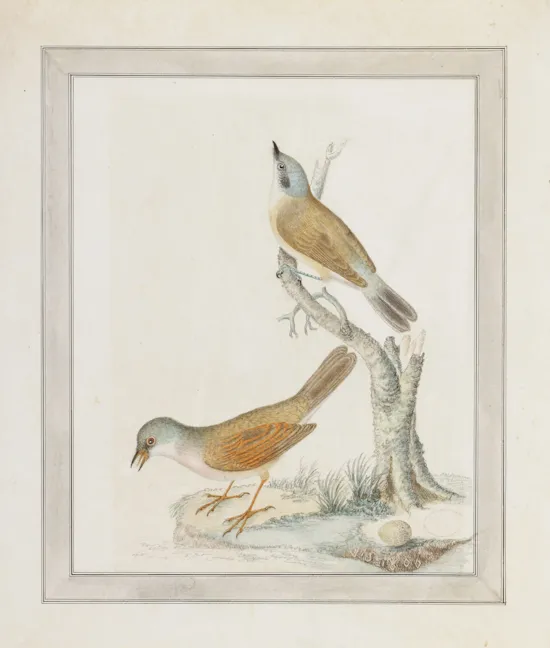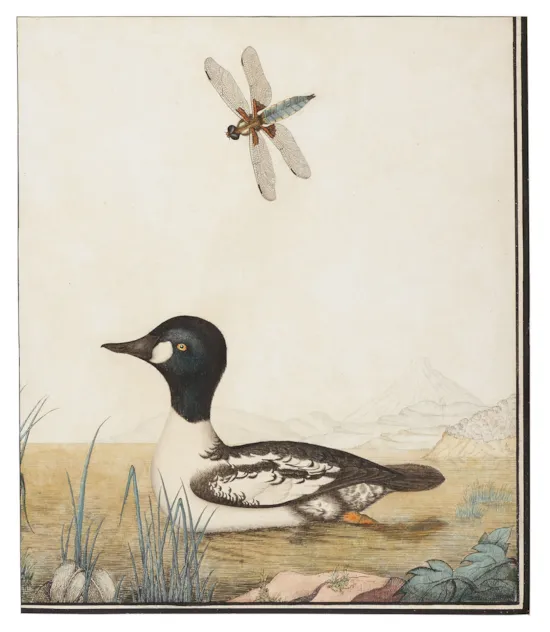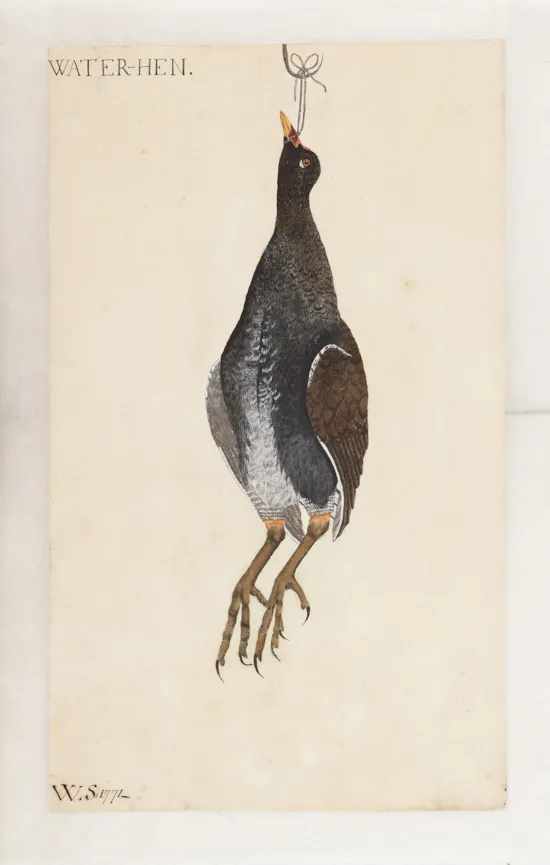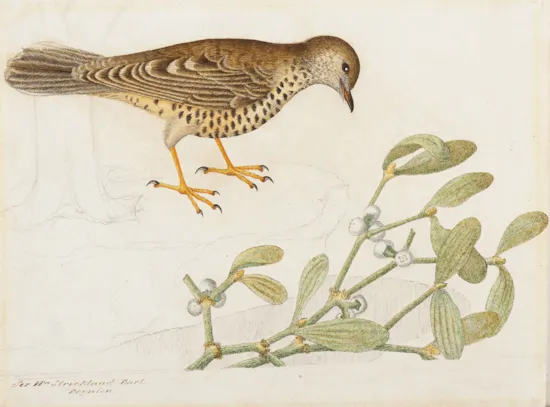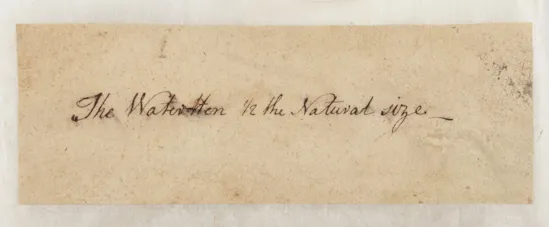Collection of Fifteen Fine English Ornithological Watercolours
A Collection of Fifteen Fine English Ornithological Watercolours Ten by Sir William Strickland 6th BT (1753 - 1834) and Five by his Brother George Strickland (1760 - 1832)
Circa 1774 - 1810
Ten studies by Sir William Strickland 6th BT (1753 - 1834) comprising:
‘White Throats’ watercolour and pencil on paper initialled and dated ‘W S 1806’
Size: 36cm high, 31cm wide - 14 ins high, 12¼ ins wide
‘Mistle Thrush’ watercolour & pencil on paper signed ‘Sir William Strickland Bart’ and inscribed ‘Boynton’
Size: 18cm high, 24cm wide - 7 ins high, 9½ ins wide
‘Puffin’ watercolour and pencil on paper
Size: 42cm high, 30.5cm wide - 16½ ins high, 12 ins wide
‘Peregrine Falcon Perched on a Carved Block with Egg and Butterfly Above’ watercolour and gouache on paper
Size: 34.5cm high, 24.5cm wide - 13½ ins high, 9½ ins wide
‘Young Black Throated Diver at Rest’ watercolour pencil and gouache on paper initialled and dated ‘W S 1810’
Size: 33.5cm high, 43cm wide - 13¼ ins high, 17 ins wide
‘Female Great Bustard Standing’ watercolour and gouache on paper
Size: 39 cm high, 29cm wide - 15¼ ins high, 11½ ins wide
‘Bittern Standing on a Rocky Outcrop’ watercolour and gouache on paper
Size: 35cm high, 25.5cm wide - 13¾ ins high, 10 ins wide
‘Water-Hen’ watercolour and body colour on paper initialled and dated ‘W S 1771’ inscribed to reverse on paper strip ‘The Waterhen ½ the Natural Size’
Size: 30cm high, 18cm wide - 11¾ ins high, 7 ins wide
‘Goldeneye on Water with Dragonfly Above’ watercolour and body colour on paper
Size: 29.5cm high, 25cm wide - 11½ ins high, 9¾ ins wide
‘Scaup Duck’ watercolour and body colour on paper initialled and dated ‘W S 1773’
Size: 28cm high, 44cm wide - 11 ins high, 17¼ ins wide
Five Studies by George Strickland (1760 - 1832) comprising:
‘Pochard’ watercolour and body colour on paper inscribed to reverse ‘Pochard’ initialled and dated ‘G S 76’
Size: 28.5cm high, 45.5cm wide - 11¼ ins high, 18 ins wide
‘Moor Buzzard’ (Female) inscribed to reverse and ‘Moor Buzzard’ (Male) inscribed to reverse with ‘Half Size’ watercolour and gouache on paper
Size: 29cm high, 45.5cm wide - 11½ ins high, 18 ins wide and 30cm high, 45.5cm wide - 11¾ ins high, 18 ins wide
‘Redwing’ inscribed to reverse initialled and dated ‘G S 84’ watercolour and body colour on paper
Size: 32cm high, 46.5cm wide - 12½ ins high, 18¼ ins wide
‘Loxia the Crofsbill’ (Crossbills) inscribed to reverse watercolour and body colour on paper
Size: 30cm high, 49cm wide - 11¾ ins high, 19¼ ins wide
All of the Five Studies are inscribed to the reverse with the Size, Weight and Species of Bird
Circa 1774 - 1810
Ten studies by Sir William Strickland 6th BT (1753 - 1834) comprising:
‘White Throats’ watercolour and pencil on paper initialled and dated ‘W S 1806’
Size: 36cm high, 31cm wide - 14 ins high, 12¼ ins wide
‘Mistle Thrush’ watercolour & pencil on paper signed ‘Sir William Strickland Bart’ and inscribed ‘Boynton’
Size: 18cm high, 24cm wide - 7 ins high, 9½ ins wide
‘Puffin’ watercolour and pencil on paper
Size: 42cm high, 30.5cm wide - 16½ ins high, 12 ins wide
‘Peregrine Falcon Perched on a Carved Block with Egg and Butterfly Above’ watercolour and gouache on paper
Size: 34.5cm high, 24.5cm wide - 13½ ins high, 9½ ins wide
‘Young Black Throated Diver at Rest’ watercolour pencil and gouache on paper initialled and dated ‘W S 1810’
Size: 33.5cm high, 43cm wide - 13¼ ins high, 17 ins wide
‘Female Great Bustard Standing’ watercolour and gouache on paper
Size: 39 cm high, 29cm wide - 15¼ ins high, 11½ ins wide
‘Bittern Standing on a Rocky Outcrop’ watercolour and gouache on paper
Size: 35cm high, 25.5cm wide - 13¾ ins high, 10 ins wide
‘Water-Hen’ watercolour and body colour on paper initialled and dated ‘W S 1771’ inscribed to reverse on paper strip ‘The Waterhen ½ the Natural Size’
Size: 30cm high, 18cm wide - 11¾ ins high, 7 ins wide
‘Goldeneye on Water with Dragonfly Above’ watercolour and body colour on paper
Size: 29.5cm high, 25cm wide - 11½ ins high, 9¾ ins wide
‘Scaup Duck’ watercolour and body colour on paper initialled and dated ‘W S 1773’
Size: 28cm high, 44cm wide - 11 ins high, 17¼ ins wide
Five Studies by George Strickland (1760 - 1832) comprising:
‘Pochard’ watercolour and body colour on paper inscribed to reverse ‘Pochard’ initialled and dated ‘G S 76’
Size: 28.5cm high, 45.5cm wide - 11¼ ins high, 18 ins wide
‘Moor Buzzard’ (Female) inscribed to reverse and ‘Moor Buzzard’ (Male) inscribed to reverse with ‘Half Size’ watercolour and gouache on paper
Size: 29cm high, 45.5cm wide - 11½ ins high, 18 ins wide and 30cm high, 45.5cm wide - 11¾ ins high, 18 ins wide
‘Redwing’ inscribed to reverse initialled and dated ‘G S 84’ watercolour and body colour on paper
Size: 32cm high, 46.5cm wide - 12½ ins high, 18¼ ins wide
‘Loxia the Crofsbill’ (Crossbills) inscribed to reverse watercolour and body colour on paper
Size: 30cm high, 49cm wide - 11¾ ins high, 19¼ ins wide
All of the Five Studies are inscribed to the reverse with the Size, Weight and Species of Bird
Sir William Strickland and his brother George were sons of Sir George Strickland, a Yorkshire agriculturist who introduced new methods of crop rotation and farm machinery, and who was also a patron of the artist Arthur Devis and of William Kent who remodelled much of the interior of Boynton Hall, and remade many of the earlier fire surrounds in the Paladian style during the 1730’s. John Carr of York was also employed as an architect and made further alterations to the family seat 1765 - 1780.
William the eldest son was a keen naturalist and honorary member of the British board of Agriculture. He established his own farm at Welburn in Yorkshire before succeeding his father as 6th Baron of Boynton in 1808. He toured America in 1794 and 1795 sketching scenic landmarks and collecting information on American farming practices for the Board which he later used as the basis for a critical assessment: ‘Observations on the Agriculture of the U.S.A.’ London 1801. During his visit to Monticello in May 1795 Thomas Jefferson gave him drawings and a small model of his mouldboard plough which Strickland praised as an invention ‘formed upon the truest and most mechanical principal of any I had seen’ The subsequent correspondence between them was marked by exchanges of publications, seeds and information on agriculture and natural history and continued until 1805.
Sir William Strickland’s depiction of the Great Bustard is especially significant as it was said that the last Great Bustard in Britain was shot at Boynton Hall around 1832. In the family archives there is an invitation to dine at Boynton Hall in which he describes the principal dish, a Great Bustard, as probably ‘the last of its race’.
William the eldest son was a keen naturalist and honorary member of the British board of Agriculture. He established his own farm at Welburn in Yorkshire before succeeding his father as 6th Baron of Boynton in 1808. He toured America in 1794 and 1795 sketching scenic landmarks and collecting information on American farming practices for the Board which he later used as the basis for a critical assessment: ‘Observations on the Agriculture of the U.S.A.’ London 1801. During his visit to Monticello in May 1795 Thomas Jefferson gave him drawings and a small model of his mouldboard plough which Strickland praised as an invention ‘formed upon the truest and most mechanical principal of any I had seen’ The subsequent correspondence between them was marked by exchanges of publications, seeds and information on agriculture and natural history and continued until 1805.
Sir William Strickland’s depiction of the Great Bustard is especially significant as it was said that the last Great Bustard in Britain was shot at Boynton Hall around 1832. In the family archives there is an invitation to dine at Boynton Hall in which he describes the principal dish, a Great Bustard, as probably ‘the last of its race’.
Collection of Fifteen Fine English Ornithological Watercolours
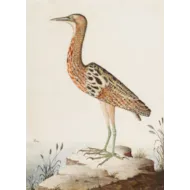
SOLD
